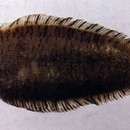Trophic Strategy
provided by Fishbase
Juveniles use mangroves as nursery ground. Adults occur up to 140m depth on continental shelf; juveniles occur in turbid waters and prefer muddy bottom (Ref. 43081).
- Recorder
- Arlene G. Sampang-Reyes
Morphology
provided by Fishbase
Dorsal spines (total): 0; Dorsal soft rays (total): 90 - 100; Analspines: 0; Analsoft rays: 72 - 78; Vertebrae: 44 - 49
- Recorder
- Estelita Emily Capuli
Diagnostic Description
provided by Fishbase
Ocular side yellow-brown. Dorsal and anal fins joined to caudal. Eyes both on the left side of the body, a narrow space separating them; asymmetrical mouth; rostral hook below mouth. Ocular side with 2 lateral lines. Only the left ventral fin present (Ref 28). With very irregular dark brown blotches, often forming irregular cross bands. Some rays of dorsal and anal fins dashed with dark brown. Scales ctenoid on both sides of body. Midlateral-line scales 78 to 99. Scale rows between lateral lines on eyed side 15 to 19 (Ref 9895).
- Recorder
- Estelita Emily Capuli
Biology
provided by Fishbase
Found on the continental shelf over sandy and muddy bottoms. Occurs in the lower courses of flowing rivers and in estuaries (Ref. 12693, 48637). Feeds mostly on benthic invertebrates. Sold fresh, frozen, or dried salted in markets (Ref. 6806).
- Recorder
- Crispina B. Binohlan
Comprehensive Description
provided by Smithsonian Contributions to Zoology
Cynoglossus puncticeps (Richardson)
Plagusia puncticeps Richardson, 1846:280 [type-locality: China].—Whitehead, 1969:218, pl. 29c.
Cynoglossus puncticeps.—Günther. 1862:500.—Bleeker, 1875: 37, pl. 245: 15, fig. 7.—Day, 1877:437, pl. 97: fig. 1; 1889:459.—Alcock, 1889:289.—Jordan and Seale, 1907:46.—Jenkins. 1910:30.—Norman, 1928:205.—Weber and de Beaufort, 1929:198.—Chu, 1931:94.—Herre, 1932:433.—Wu, 1932:151 [Amoy, Pehai, Canton, Hong Kong, and Hainan].—Smith, 1933:84.—Fowler, 1934b:220. fig. 34.—Suvatti, 1950:328.—Herre, 1953:190.—Munro. 1955:265, pl. 51: fig. 771.—Fowler, 1956:137.—De Silva, 1956:198 [Panadura].—Munro, 1958:285 [Kau Kau].—Kuronuma, 1961:32.—Punpoka, 1964:69 [Thailand].—Pradhan, 1964: 458.—Chen and Weng, 1965:91, fig. 62 [Tainan and Tungkong].—Shen, 1967:214, figs. 138–141 [Lamma Island].
Plagusia nigrolabeculata Richardson, 1846:280 [coasts of China. Canton].—Kaup, 1858:110.—Whitehead, 1969:218, pl. 29b.
Cynoglossus nigrolabecutatus.—Bleeker, 1873:131 [reference].
Plagusia aurolimbata Richardson, 1846:280 [coasts of China].—Kaup, 1858:110.—Whitehead, 1969:218, pl. 28b.
Cynoglossus aurolineatus.—Bleeker, 1873:130.
Plagusia javanica Bleeker, 1851a:414 [type-locality: Batavia]; 1852:24.
Arelia javanica.—Bleeker, 1859:184.
Plagusia brachyrhynchos Bleeker, 1851a:414 [type-locality: Batavia]; 1852:24.
Arelia brachyrhynchos.—Bleeker, 1859:184.
Cynoglossus brachyrhynchus.—Günther, 1862:499.—Bleeker, 1875:37, pl. 243: fig. 4.—Day, 1877:435, pl. 96: fig. 4; 1839:457.—Johnstone, 1904:206.—Weber, 1913b:443.
Cynoglossus brevis Günther, 1862:500 [type-locality: Ganges].—Day, 1877:437, pl. 97: fig. 2.—Alcock, 1889:289.—Hora, 1923b:760,—Norman, 1928:206.
Cynoglossus lida [not Bleeker].—Jenkins, 1910a:31.
Cynoglossus lida var. punctatus.—Jenkins, 1910a:30.
Cynoglossus puncticeps immaculata Pellegrin and Chevey, 1940:154 [Vietnam].
DESCRIPTION: Based on 87 specimens, 35.0–166.0 mm SL, including the paralectotype of C. brevis.
Depth of body 12.05–45.16 (M = 28.43), length of head 11.45–30.65 (M = 22.22) percent of standard length. Diameter of eye 6.25–16.13 (M = 10.71), interorbital space rather narrow, 0.36–6.67 (M = 3.03) percent of length of head. Two nostrils on ocular side, anterior nostrils tubular, in front of lower eye, posterior nostril simple, immediately in front of interorbital space. Snout rounded or obtusely pointed, 24.39–41.18 (M = 32.67) percent of length of head, rostral hook short, usually ends in front of anterior nostril, rarely reaching below anterior border of fixed eye. Maxillary extending to below middle or posterior half of fixed eye; angle of mouth extending to below vertical from anterior half or middle of fixed eye, usually nearer to tip of snout than to branchial opening; tip of snout to angle of mouth 34.21–51.43 (M = 44.16), angle of mouth to branchial opening 41.67–72.73 (M = 55.62) percent of length of head.
Scales: Ctenoid on both sides, including those of lateral lines.
Lateral-Line System: Two lateral lines on ocular side, dorsolateral line slightly undulating, running backward and entering dorsal fin along 5th–6th ray, counted from the rear, midlateral line with 78–99 (M = 87) scales, 14–19 (M = 16) scales between them. No lateral line on blind side.
Interlinear scale rows 14 15 16 17 18 19
Frequencies 4 6 22 23 16 9
Fins: Dorsal with 90–100 (M = 96) rays, anal with 72–78 (M = 75) rays, caudal 10 in 57 specimens (radiographs).
Vertebrae: 44–49, comprising 9 abdominal and 35–40 caudal elements in 57 specimens (radiographs).
Coloration: Upper side brownish with dark blotches all over the body, appearing as somewhat irregular crossbands that disappear with age, lower whitish. Some of the rays of the vertical fins marked with dark brown.
Size: Largest specimen examined, 175 (161 + 14) mm, is from Sind, Pakistan.
DISTRIBUTION.—From northwest Australia, Malay Archipelago to Philippines, through South China Sea to Taiwan, and westward to seas of India; recorded from a depth of 7–75 fms and known from brackish waters as well.
DIAGNOSIS AND
- bibliographic citation
- Menon, A. G. K. 1977. "A systematic monograph of the tongue soles of the genus Cynoglossus Hamilton-Buchanan (Pisces, Cynoglossidae)." Smithsonian Contributions to Zoology. 1-129. https://doi.org/10.5479/si.00810282.238
分布
provided by The Fish Database of Taiwan
分布於印度-西太平洋區,由巴基斯坦、印度至菲律賓及臺灣,南可至澳洲西北部。台灣南部海域有產。
描述
provided by The Fish Database of Taiwan
體長舌形,極側扁;兩眼均位於左側,兩眼稍分開。鼻孔兩個。口小,下位,口裂弧形;口角緣近於鰓蓋後緣;上頜向後達下眼前緣下方;眼側無齒,盲側具細小絨毛狀齒;鋤骨與腭骨無齒;眼側唇緣無觸鬚或穗狀物。鰓膜與峽部分離。兩側被櫛鱗,眼間隔處具鱗片;眼側有2條側線;側線鱗數93-99;兩側線間鱗數15-19。背鰭、臀鰭與尾鰭相連;無胸鰭;腹鰭與臀鰭相連;尾鰭尖形;背鰭軟條數
90-100;臀鰭軟條數 70-80;腹鰭軟條數
4;尾鰭軟條數10;脊椎骨數48-49。眼側褐色而散布黑斑塊,鰭黃褐色,具黑褐色垂直條紋;盲側淡色,鰭淡灰白色。
斑头舌鳎: Brief Summary
(
Chinese
)
provided by wikipedia 中文维基百科
斑头舌鳎(学名:Cynoglossus puncticeps)为輻鰭魚綱鰈形目鰨亞目舌鳎科舌鳎属的鱼类,俗名龙利、挞沙、花龙鱼等、狗舌、鞋底、花舌。分布于西达巴基斯坦、南达印度尼西亚、东达菲律宾以及两广到福建及台湾等近海等,属于暖水性浅海底层鱼,棲息深度1-140公尺,體長可達35公分,棲息在沙泥底質底層水域,以底棲性無脊椎動物為食,生活習性不明,可做為食用魚。该物种的模式产地在中国。

